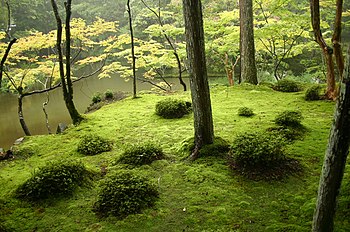
Japanese gardens (日本庭園, nihon teien) are traditional gardens whose designs are accompanied by Japanese aesthetics and philosophical ideas, avoid artificial ornamentation, and highlight the natural landscape. Plants and worn, aged materials are generally used by Japanese garden designers to suggest a natural landscape, and to express the fragility of existence as well as time's unstoppable advance.[1]: 6 Ancient Japanese art inspired past garden designers.[1]: 6 Water is an important feature of many gardens, as are rocks and often gravel. Despite there being many attractive Japanese flowering plants, herbaceous flowers generally play much less of a role in Japanese gardens than in the West, though seasonally flowering shrubs and trees are important, all the more dramatic because of the contrast with the usual predominant green. Evergreen plants are "the bones of the garden" in Japan.[2] Though a natural-seeming appearance is the aim, Japanese gardeners often shape their plants, including trees, with great rigour.

Japanese literature on gardening goes back almost a thousand years, and several different styles of garden have developed, some with religious or philosophical implications. A characteristic of Japanese gardens is that they are designed to be seen from specific points. Some of the most significant different traditional styles of Japanese garden are the chisen-shoyū-teien ("lake-spring-boat excursion garden"), which was imported from China during the Heian period (794–1185). These were designed to be seen from small boats on the central lake. No original examples of these survive, but they were replaced by the "paradise garden" associated with Pure Land Buddhism, with a Buddha shrine on an island in the lake. Later large gardens are often in the kaiyū-shiki-teien, or promenade garden style, designed to be seen from a path circulating around the garden, with fixed stopping points for viewing. Specialized styles, often small sections in a larger garden, include the moss garden, the dry garden with gravel and rocks, associated with Zen Buddhism, the roji or teahouse garden, designed to be seen only from a short pathway, and the tsubo-niwa, a very small urban garden.
Most modern Japanese homes have little space for a garden, though the tsubo-niwa style of tiny gardens in passages and other spaces, as well as bonsai (in Japan always grown outside) and houseplants mitigates this, and domestic garden tourism is very important. The Japanese tradition has long been to keep a well-designed garden as near as possible to its original condition,[3] and many famous gardens appear to have changed little over several centuries, apart from the inevitable turnover of plants, in a way that is extremely rare in the West.


Awareness of the Japanese style of gardening reached the West near the end of the 19th century, and was enthusiastically received as part of the fashion for Japonisme, and as Western gardening taste had by then turned away from rigid geometry to a more naturalistic style, of which the Japanese style was an attractive variant. There were immediately popular in the UK, where the climate was similar and Japanese plants grew well. Japanese gardens, typically a section of a larger garden, continue to be popular in the West, and many typical Japanese garden plants, such as cherry trees and the many varieties of Acer palmatum or Japanese maple, are also used in all types of garden, giving a faint hint of the style to very many gardens.